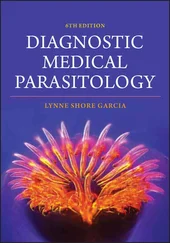Alan Gunn - Parasitology
Здесь есть возможность читать онлайн «Alan Gunn - Parasitology» — ознакомительный отрывок электронной книги совершенно бесплатно, а после прочтения отрывка купить полную версию. В некоторых случаях можно слушать аудио, скачать через торрент в формате fb2 и присутствует краткое содержание. Жанр: unrecognised, на английском языке. Описание произведения, (предисловие) а так же отзывы посетителей доступны на портале библиотеки ЛибКат.
- Название:Parasitology
- Автор:
- Жанр:
- Год:неизвестен
- ISBN:нет данных
- Рейтинг книги:3 / 5. Голосов: 1
-
Избранное:Добавить в избранное
- Отзывы:
-
Ваша оценка:
- 60
- 1
- 2
- 3
- 4
- 5
Parasitology: краткое содержание, описание и аннотация
Предлагаем к чтению аннотацию, описание, краткое содержание или предисловие (зависит от того, что написал сам автор книги «Parasitology»). Если вы не нашли необходимую информацию о книге — напишите в комментариях, мы постараемся отыскать её.
Highly detailed textbook on parasites and parasite relationships Parasitology: An Integrated Approach
Parasitology: An Integrated Approach, 2nd edition
Parasitology — читать онлайн ознакомительный отрывок
Ниже представлен текст книги, разбитый по страницам. Система сохранения места последней прочитанной страницы, позволяет с удобством читать онлайн бесплатно книгу «Parasitology», без необходимости каждый раз заново искать на чём Вы остановились. Поставьте закладку, и сможете в любой момент перейти на страницу, на которой закончили чтение.
Интервал:
Закладка:
Table of Contents
1 Cover
2 Title Page Parasitology An Integrated Approach Second Edition Alan Gunn School of Biological and Environmental Sciences Liverpool John Moores University Liverpool UK Sarah J. Pitt School of Applied Sciences University of Brighton Brighton UK
3 Copyright Page
4 Dedication
5 Preface
6 About the Companion Website
7 1 Animal Associations and the Importance of Parasites 1.1 Introduction 1.2 Animal Associations 1.3 Parasite Hosts 1.4 Zoonotic Infections 1.5 The Co‐evolution of Parasites and Their Hosts 1.6 Parasitism as a ‘Lifestyle’: Advantages and Limitations 1.7 The Economic Cost of Parasitic Diseases 1.8 Why Parasitic Diseases Remain a Problem
8 2 Taxonomy 2.1 Introduction 2.2 Viruses: A Special (Unresolved) Case 2.3 Taxonomic Hierarchy 2.4 Kingdom Protista 2.5 Kingdom Animalia
9 3 Parasitic Protozoa Part A: Phyla Rhizopoda, Metamonada, Apicomplexa 3.1 Introduction 3.2 Phylum Rhizopoda 3.3 Phylum Metamonada 3.4 Phylum Apicomplexa 3.5 Subclass Coccidiasina
10 4 Parasitic Protozoa Part B: Phylum Kinetoplastida; Parasitic Algae and Fungi 4.1 Introduction 4.2 Phylum Kinetoplastida 4.3 Phylum Chlorophyta 4.4 Kingdom Fungi
11 5 Platyhelminth and Acanthocephalan Parasites 5.1 Introduction 5.2 Phylum Platyhelminthes 5.3 Class Cestoda 5.4 Phylum Acanthocephala
12 6 Nematode Parasites 6.1 Introduction 6.2 Class Enoplea 6.3 Class Rhabdita
13 7 Arthropod Parasites 7.1 Introduction 7.2 Phylum Chelicerata 7.3 Phylum Crustacea 7.4 Subphylum Hexapoda
14 8 Parasite Transmission 8.1 Introduction 8.2 Contaminative Transmission 8.3 Transmission Associated with Reproduction 8.4 Autoinfection 8.5 Nosocomial Transmission 8.6 Active Parasite Transmission 8.7 Hosts and Vectors 8.8 Host Factors 8.9 Co‐Transmission and Interactions Between Pathogens 8.10 Environmental Factors
15 9 Immune Reactions to Parasitic Infections 9.1 Introduction 9.2 Invertebrate Immunity 9.3 Vertebrate Immunity 9.4 Innate Immunity to Parasites 9.5 Adaptive Immune Reactions to Parasites 9.6 Microbiomes and Host Immune Reactions to Parasites 9.7 Avoiding the Host Immune Response 9.8 Immunity to Malaria 9.9 Schistosoma spp. and Hepatitis C Virus Interactions 9.10 HIV‐AIDS and Parasitic Infections
16 10 Pathology Part A 10.1 Introduction 10.2 Factors Influencing Pathogenesis 10.3 Mechanisms By Which Parasites Cause Pathology 10.4 Types of Pathology
17 11 Pathology Part B 11.1 Introduction 11.2 Damage to Specific Organs 11.3 Co‐Infections and Pathogenesis
18 12 The Useful Parasite 12.1 Introduction: The Goodness of Parasites? 12.2 The Importance of Parasites for the Maintenance of a Healthy Immune System 12.3 The Use of Parasites to Treat Medical Conditions 12.4 Parasites as Sources of Novel Pharmaceutically Active Substances 12.5 Parasites as Biological Control Agents 12.6 Parasites as Forensic Indicators
19 13 The Identification of Protozoan and Helminth Parasites 13.1 Laboratory Testing for Parasitic Infections: Introduction 13.2 Importance of Correct Identification 13.3 Properties of an Ideal Diagnostic Test 13.4 Isolation of Parasites 13.5 Identification from Gross Morphology 13.6 Biochemical Techniques for Identification 13.7 Immunological Techniques for Identification 13.8 Molecular Techniques for Identification 13.9 Diagnostic Testing of Parasitic Infections Outside the Laboratory: Introduction
20 14 Parasite Treatment 14.1 Introduction 14.2 The Ideal Antiparasitic Drug 14.3 Pharmaceutical Drugs 14.4 DNA/RNA Technology 14.5 Molecular Chaperones (Heat Shock Proteins) 14.6 Nanotechnology 14.7 Quantum Dots 14.8 Natural Remedies 14.9 Homeopathy
21 15 Parasite Vaccines 15.1 Introduction 15.2 The Design and Use of Vaccines 15.3 Herd Immunity 15.4 Factors Limiting the Production of Commercial Antiparasitic Vaccines 15.5 Properties of an Ideal Vaccine 15.6 Types of Vaccine 15.7 Identification of Antigens for Use in Anti‐parasite Vaccines 15.8 Vaccine Delivery 15.9 Vaccines Against Malaria 15.10 Nanobodies (Single Domain Antibodies) 15.11 Problems with Vaccination Strategies
22 16 Parasite Control 16.1 Introduction 16.2 Eradication, Elimination, and Control 16.3 Education 16.4 Environmental Modification and Cultural Control 16.5 Remote Sensing and GIS Technology 16.6 Whether to Treat the Individual or the Population 16.7 Piggy‐Backing Control Programmes 16.8 Disruptions to Control Programmes 16.9 Role of Governments, Foundations, and Aid Organisations
23 References
24 Index
25 End User License Agreement
List of Tables
1 Chapter 1 Table 1.1 Summary of advantages and disadvantages associated with the paras... Table 1.2 A comparison of global disability adjusted life years (DALYs) and... Table 1.3 Summary of factors contributing to the problems of parasitic dise...
2 Chapter 2 Table 2.1 The taxonomic hierarchy with specific reference to the sheep nasa...
3 Chapter 3 Table 3.1 Representative examples of parasitic protozoa belonging to the ph... Table 3.2 The distribution, vectors, and host ranges of representative Babe ... Table 3.3 Summary of the most important species of Sarcocystis in human and... Table 3.4 Selected species of Cryptosporidium to indicate their usual host ...
4 Chapter 4 Table 4.1 Examples of kinetoplastid parasites of medical, veterinary, and a... Table 4.2 Morphological forms of Kinetoplastida parasitic in humans and dom... Table 4.3 Taxonomic divisions within the genus Leishmania . Table 4.4 Examples of Trypanosoma species of medical and veterinary importa...
5 Chapter 5 Table 5.1 Characteristics of the Turbellaria, Monogenea, Digenea, and Cesto... Table 5.2 Life cycle stages of digenetic trematodes. Table 5.3 Morphological characteristics of Schistosoma mansoni , Schistosoma ...Table 5.4 Distribution and intermediate hosts of schistosome species parasi...Table 5.5 Metacestodes (larval stages) formed by cyclophyllidean tapeworms....
6 Chapter 6Table 6.1 Species and genotypes belonging to the genus Trichinella .
7 Chapter 7Table 7.1 Morphological and developmental features exhibited by the majorit...Table 7.2 Distinguishing morphological characteristics of the phylum Chelic...Table 7.3 Taxonomic arrangement of the Acari.Table 7.4 Morphological features of the Class Insecta.Table 7.5 Examples of Diptera that act as vectors of parasitic diseases.
8 Chapter 8Table 8.1 Biological and abiotic factors that influence the toxicity of a p...Table 8.2 How a pollutant can increase the chances of parasite transmission...
9 Chapter 9Table 9.1 Principal invertebrate immune mechanisms.Table 9.2 The sequence of major immune responses that occur in a typical ma...Table 9.3 Classification of lymphocytes.Table 9.4 Classification, distribution, and function of mammalian immunoglo...Table 9.5 Mechanisms by which immunoglobulins bring about the removal of pa...Table 9.6 T helper lymphocytes and some of their functions.Table 9.7 Summary of the main mechanisms parasites employ to avoiding the h...
10 Chapter 10Table 10.1 Host factors and parasite factors that determine the pathology a...Table 10.2 Mechanisms by which parasites cause pathology.Table 10.3 Mechanisms by which parasites cause anaemia.Table 10.4 IARC classification of the ability of agents to induce cancer in...Table 10.5 Metabolic consequences of diarrhoea.
11 Chapter 12Table 12.1 Potential advantages and problems associated with helminth thera...
12 Chapter 13Table 13.1 Instances in which correct identification is important.Table 13.2 Properties of an ideal parasite diagnostic test.Table 13.3 Limitations of traditional light microscope techniques for paras...
13 Chapter 14Table 14.1 Properties ssof an ideal antiparasitic drug or treatment regime....
Читать дальшеИнтервал:
Закладка:
Похожие книги на «Parasitology»
Представляем Вашему вниманию похожие книги на «Parasitology» списком для выбора. Мы отобрали схожую по названию и смыслу литературу в надежде предоставить читателям больше вариантов отыскать новые, интересные, ещё непрочитанные произведения.
Обсуждение, отзывы о книге «Parasitology» и просто собственные мнения читателей. Оставьте ваши комментарии, напишите, что Вы думаете о произведении, его смысле или главных героях. Укажите что конкретно понравилось, а что нет, и почему Вы так считаете.












